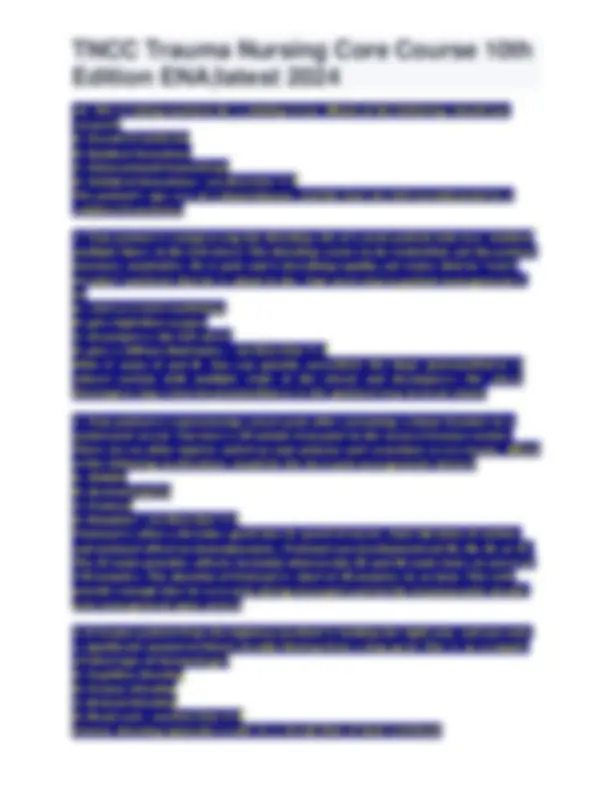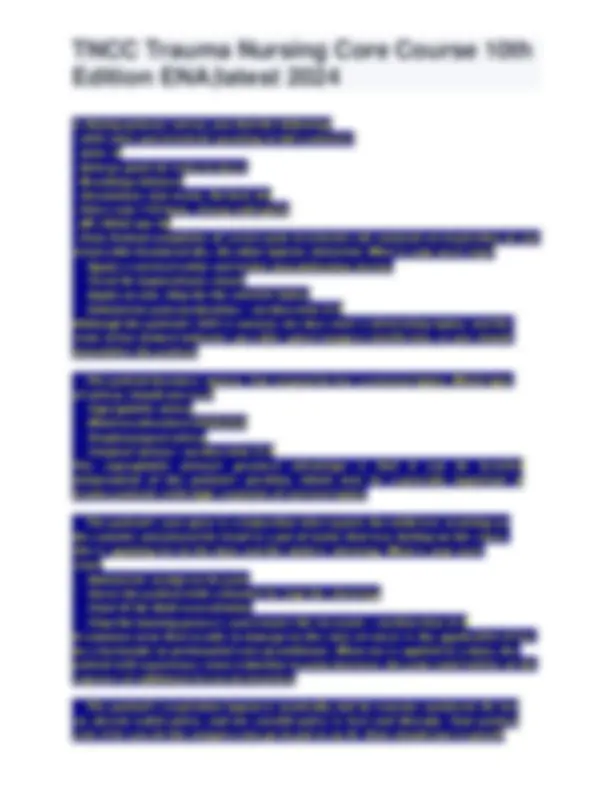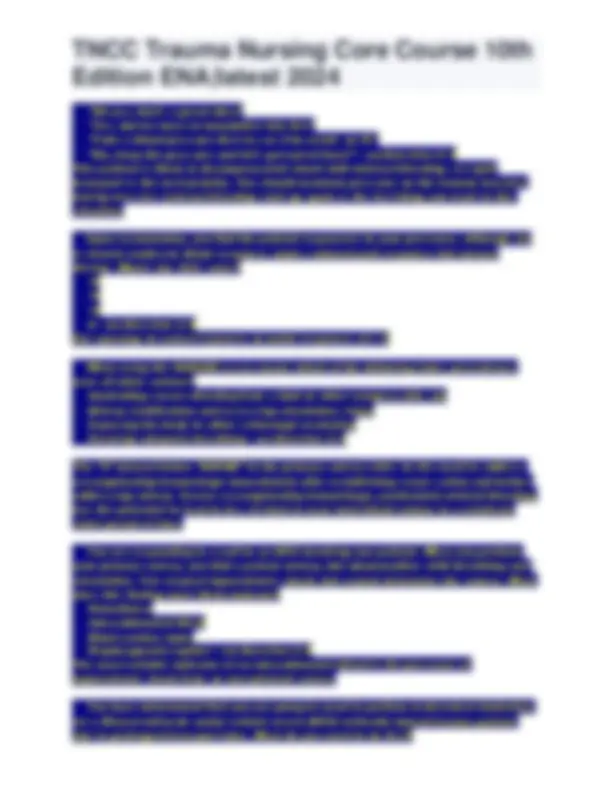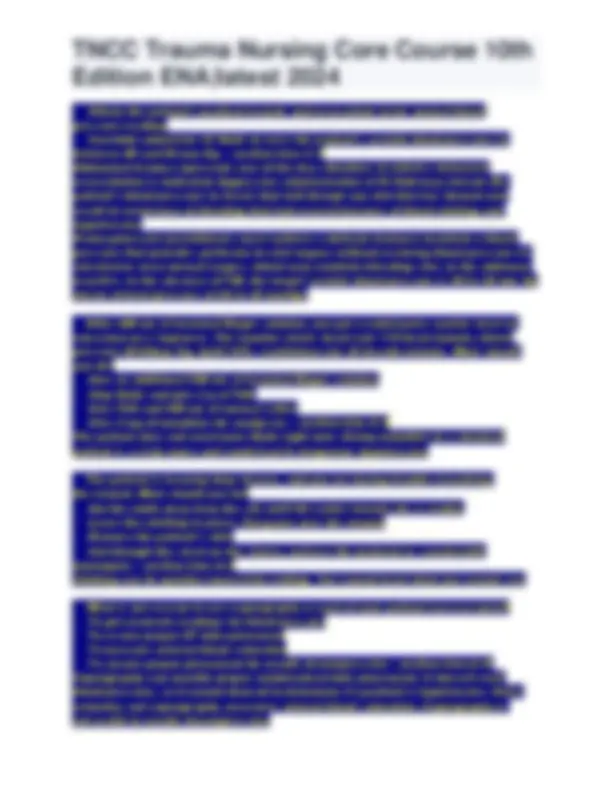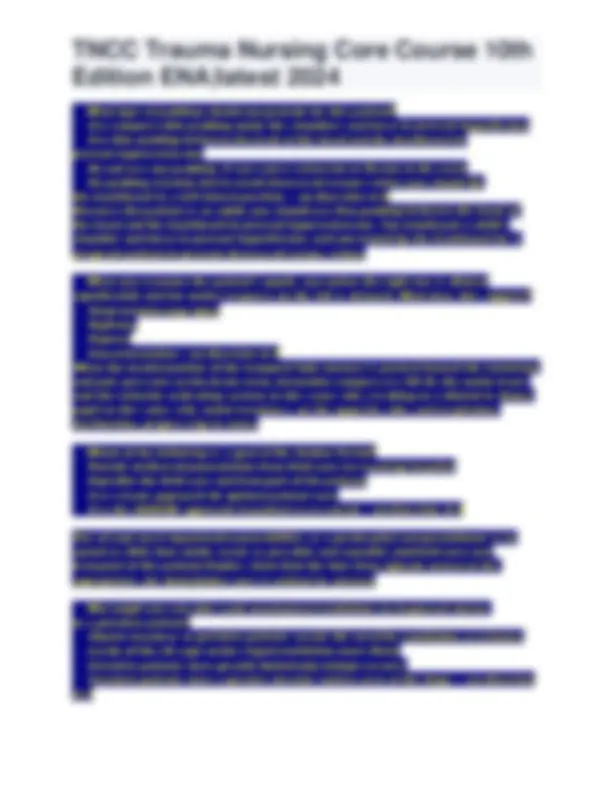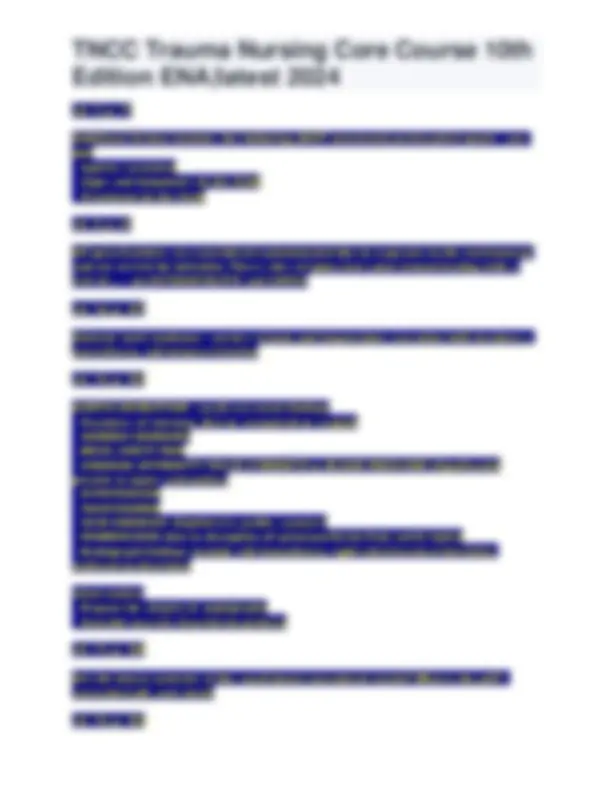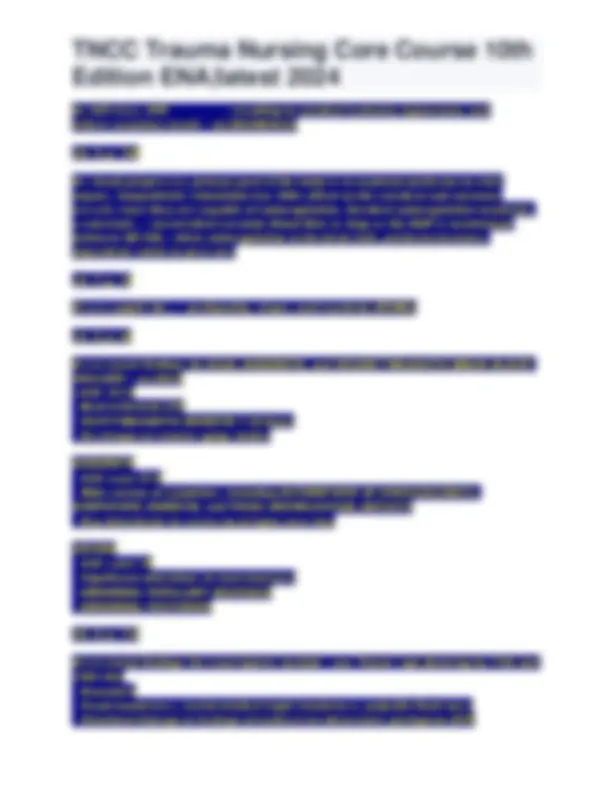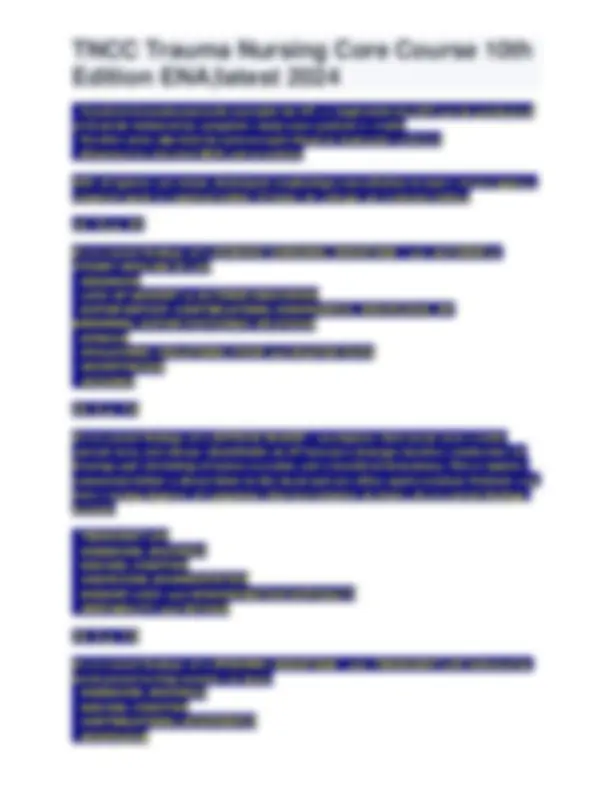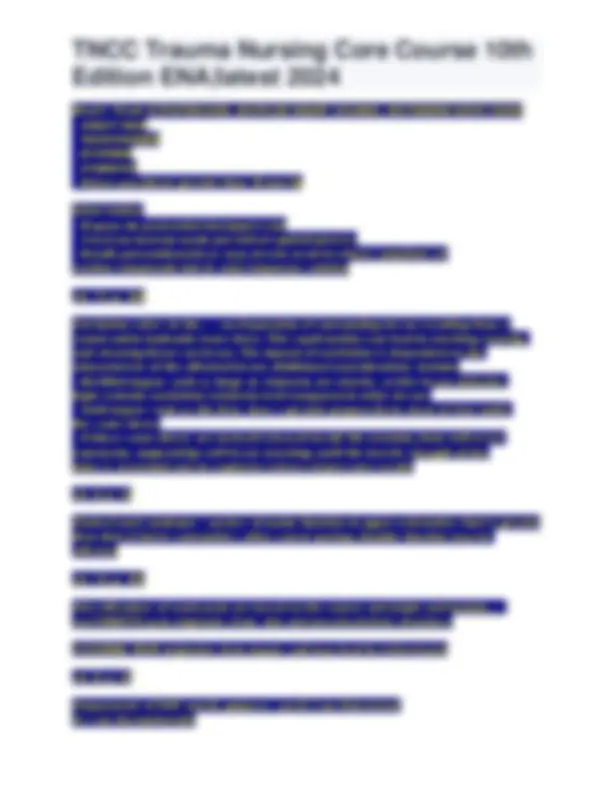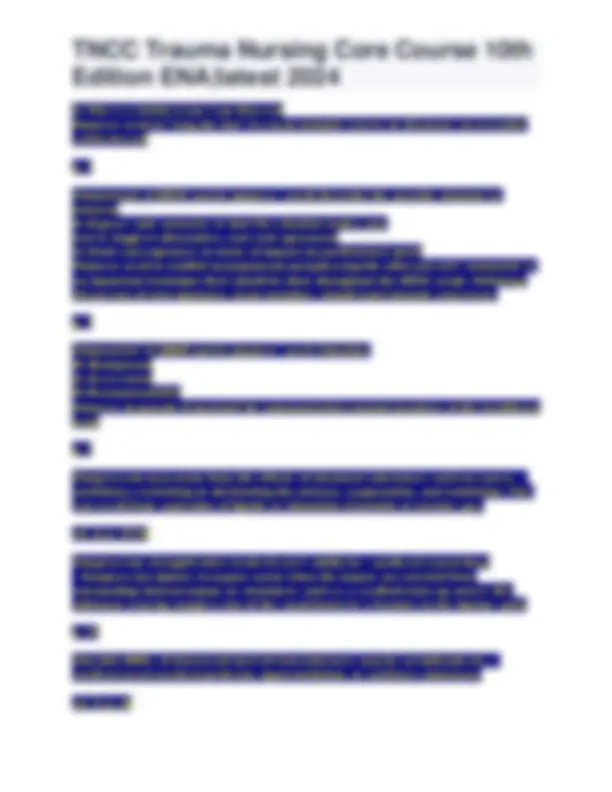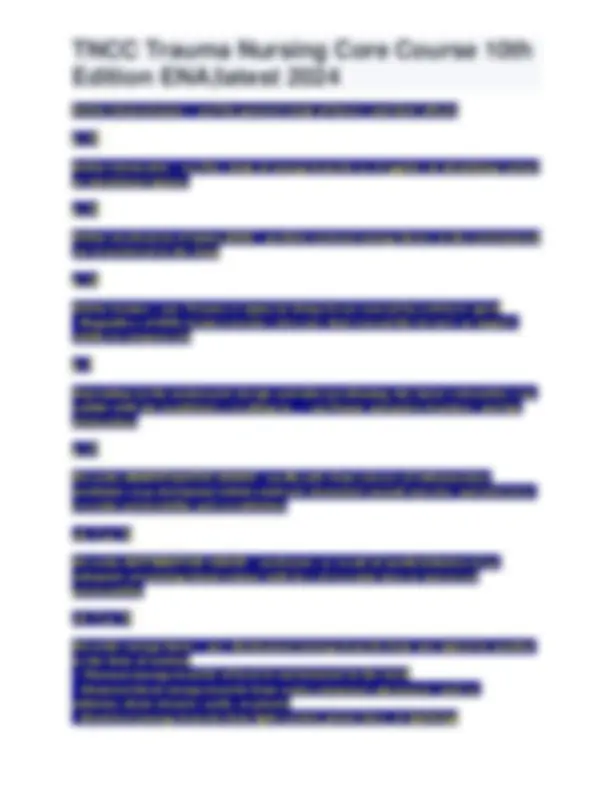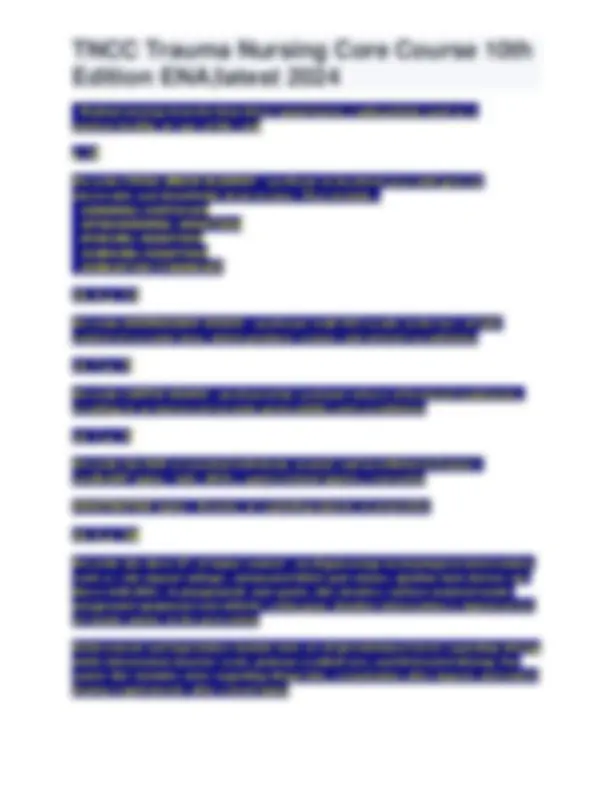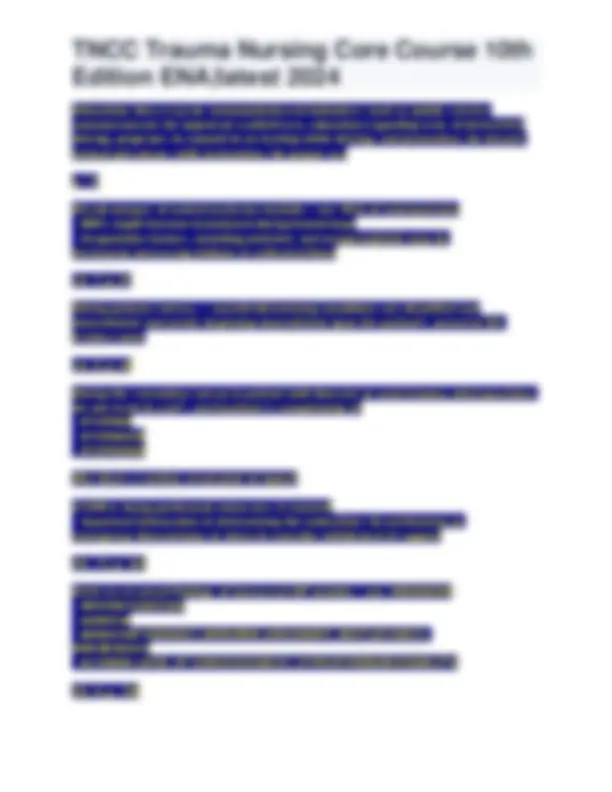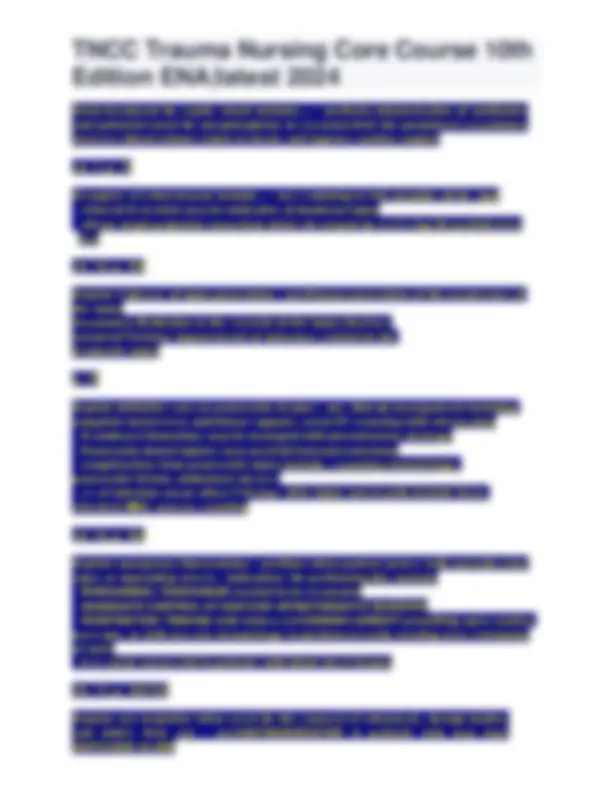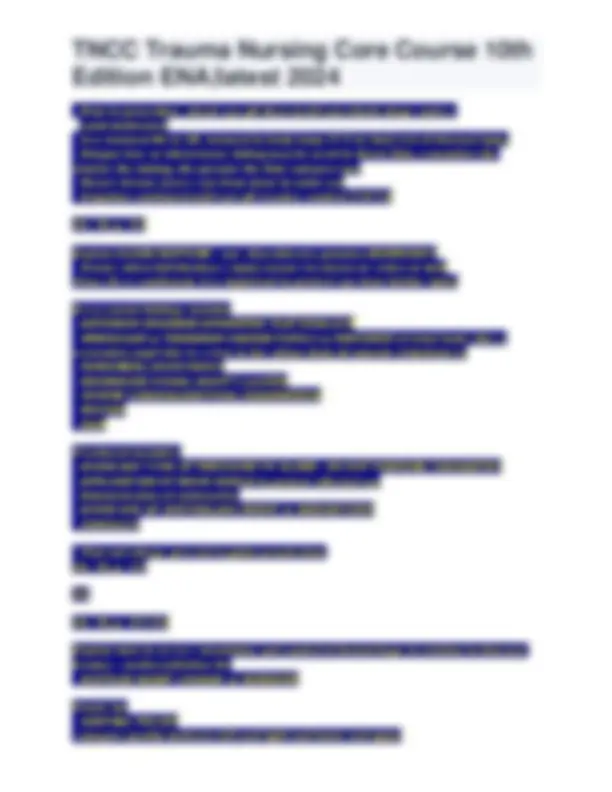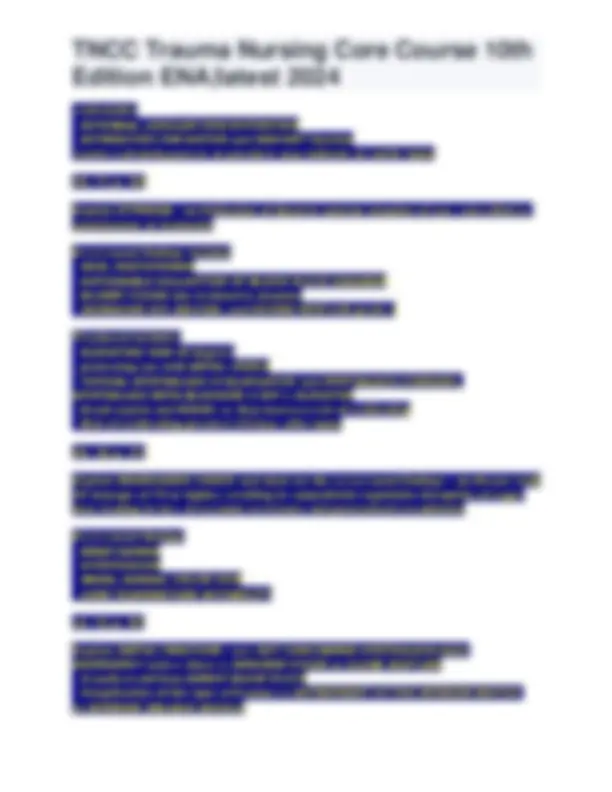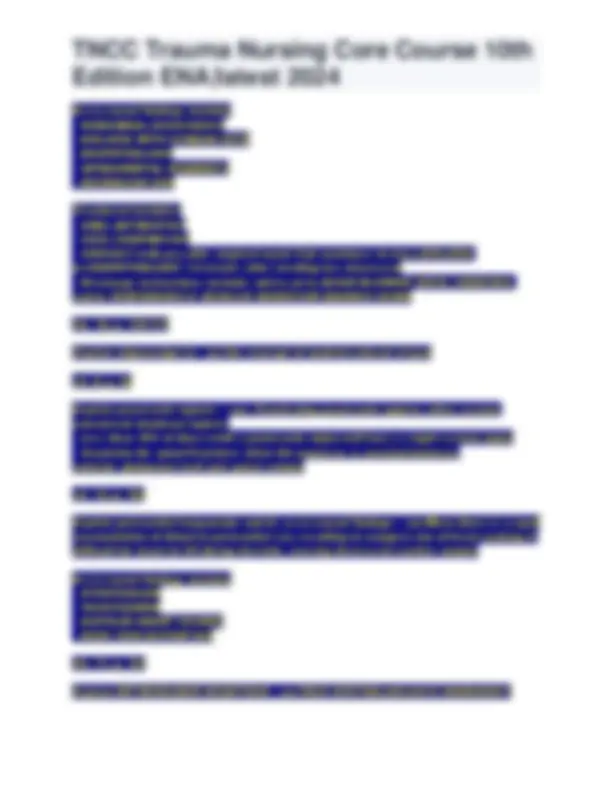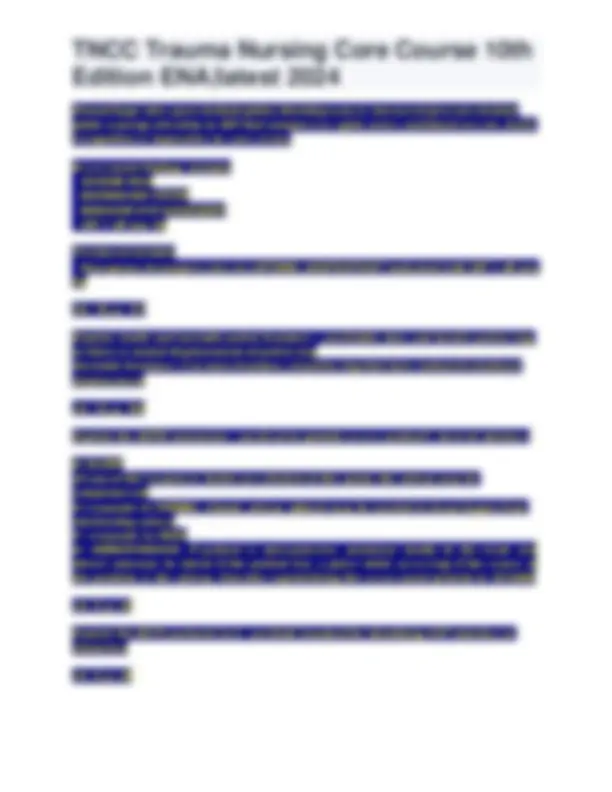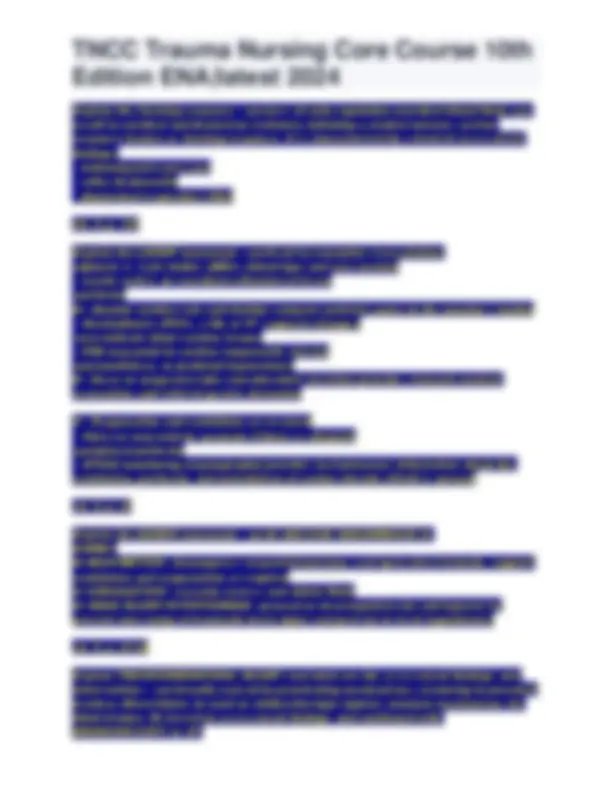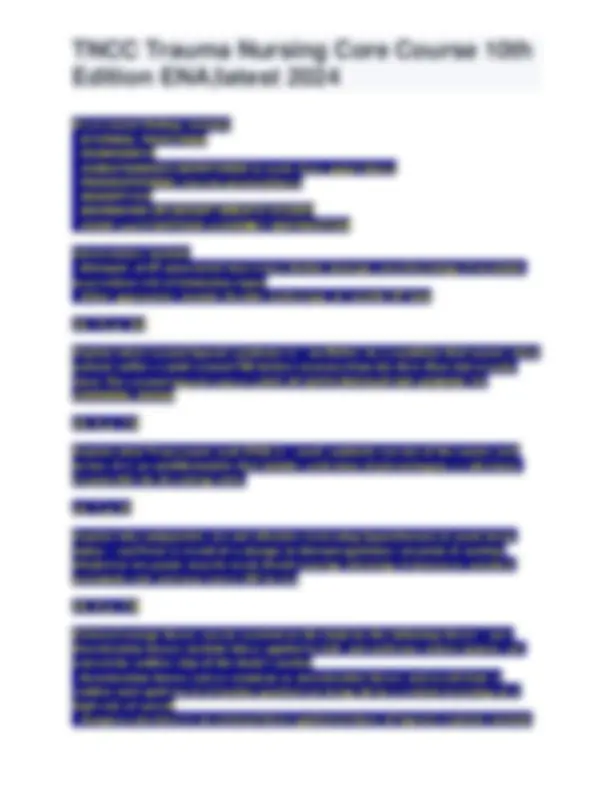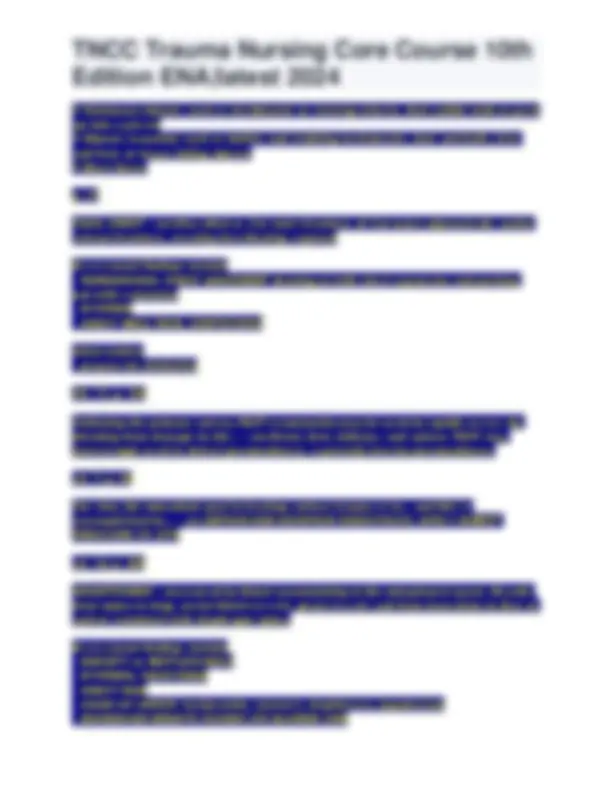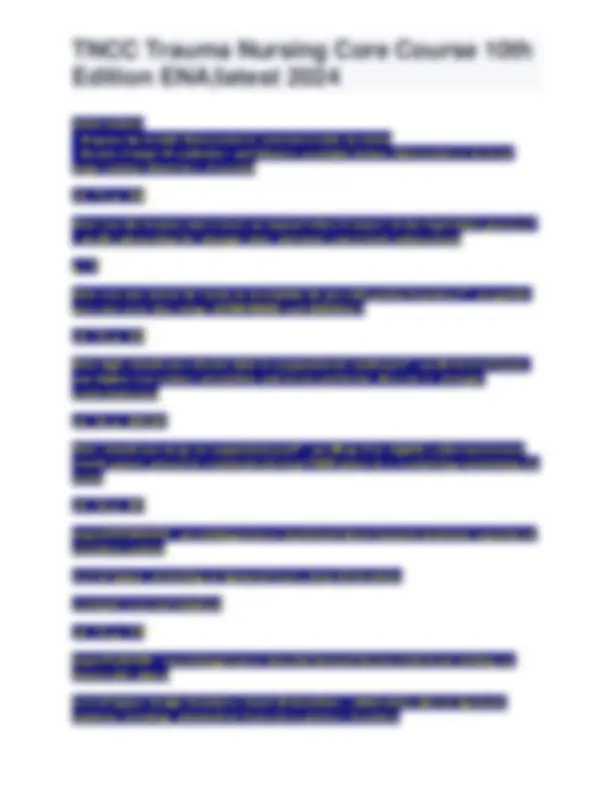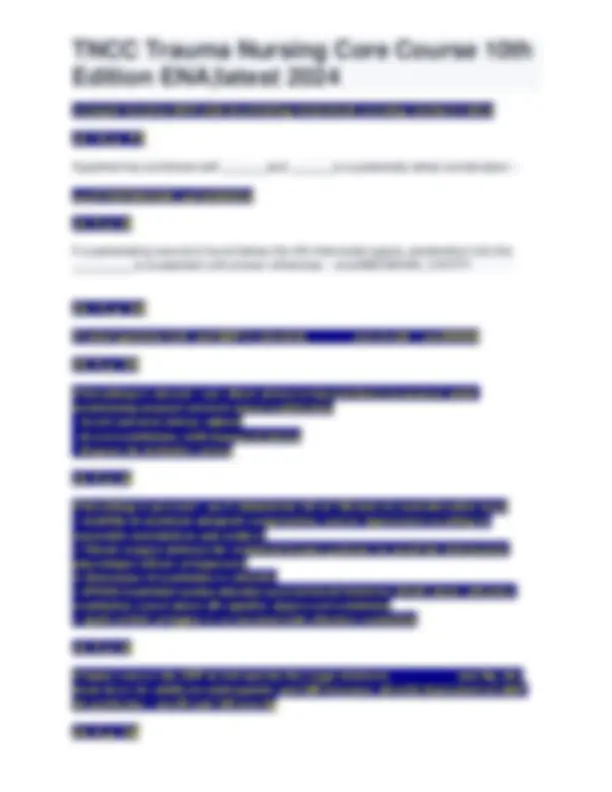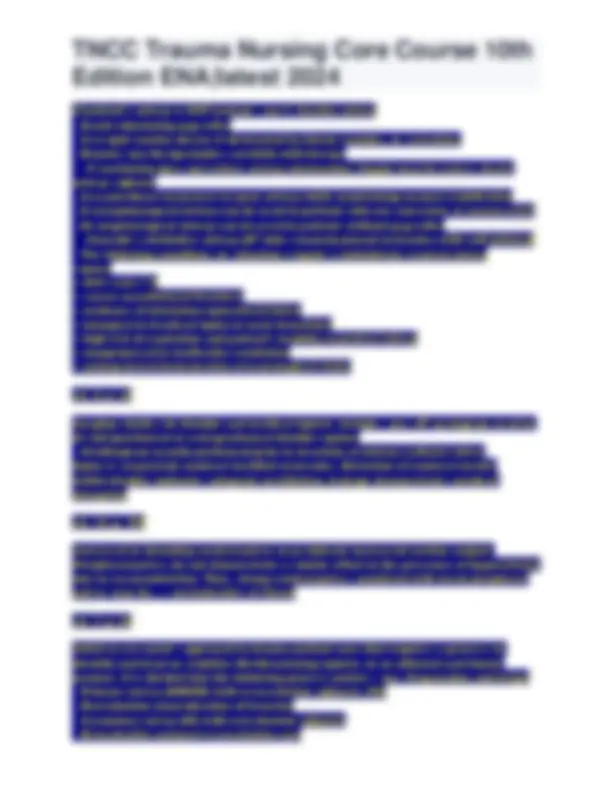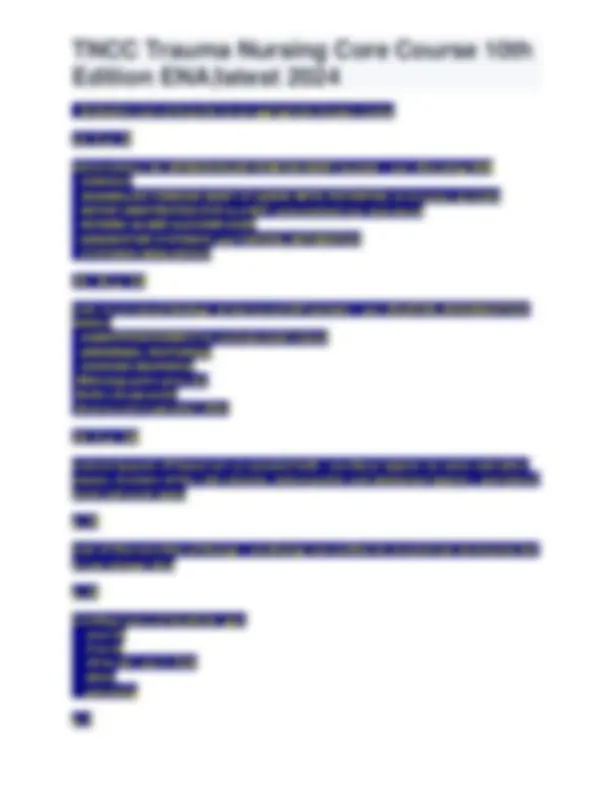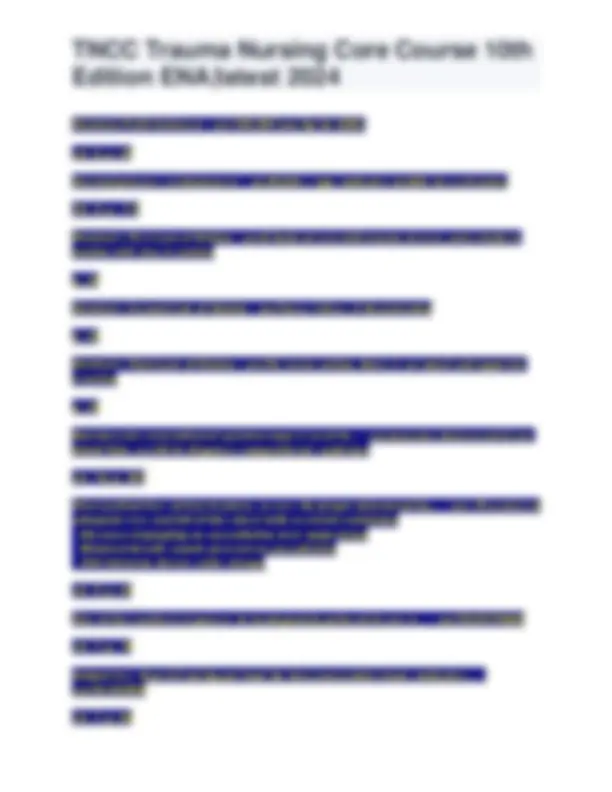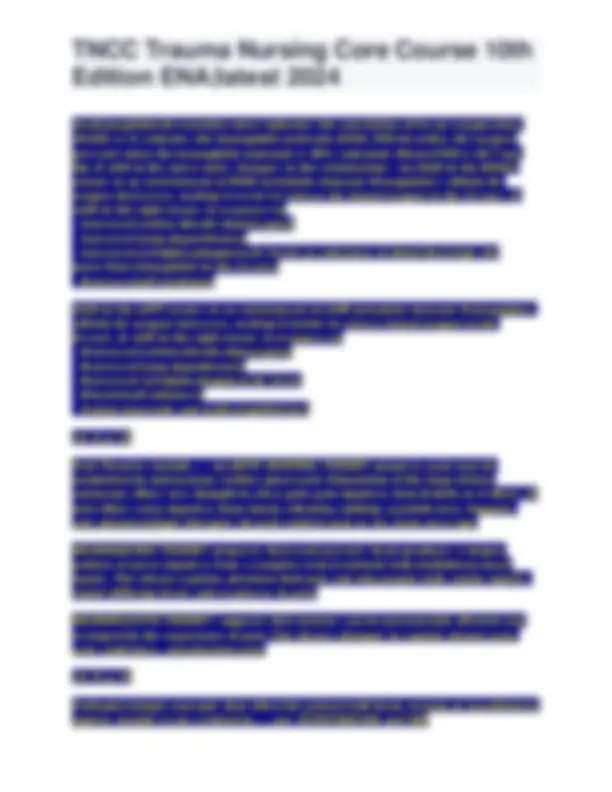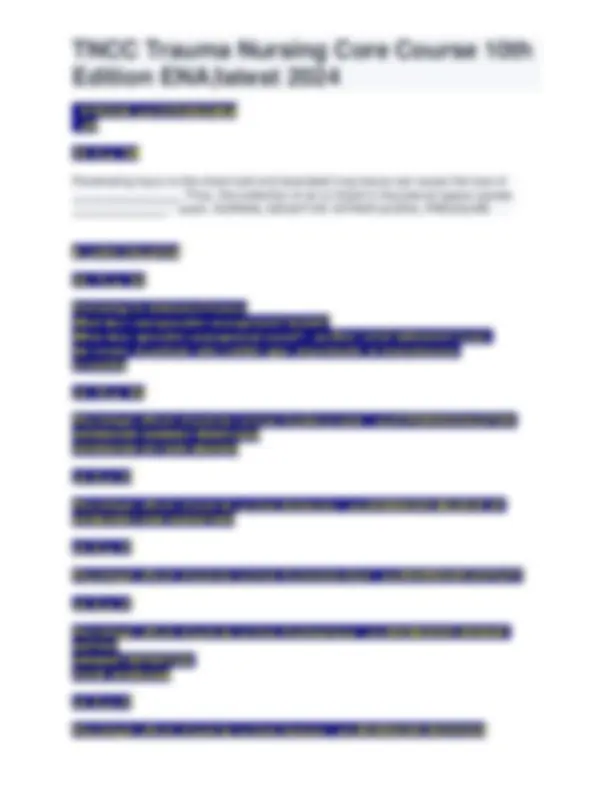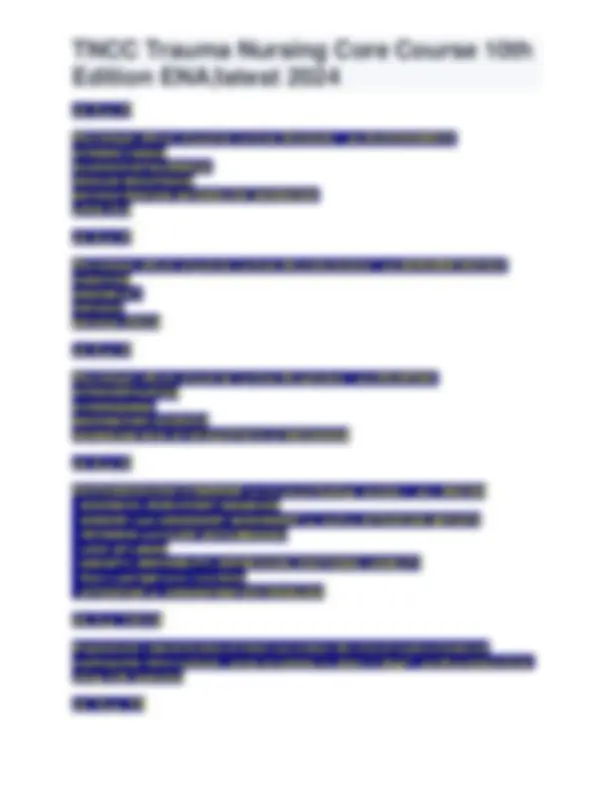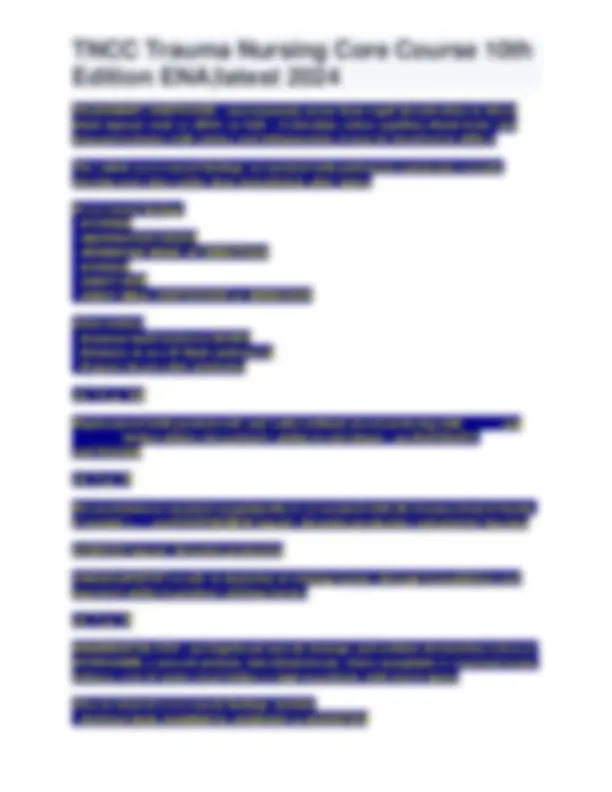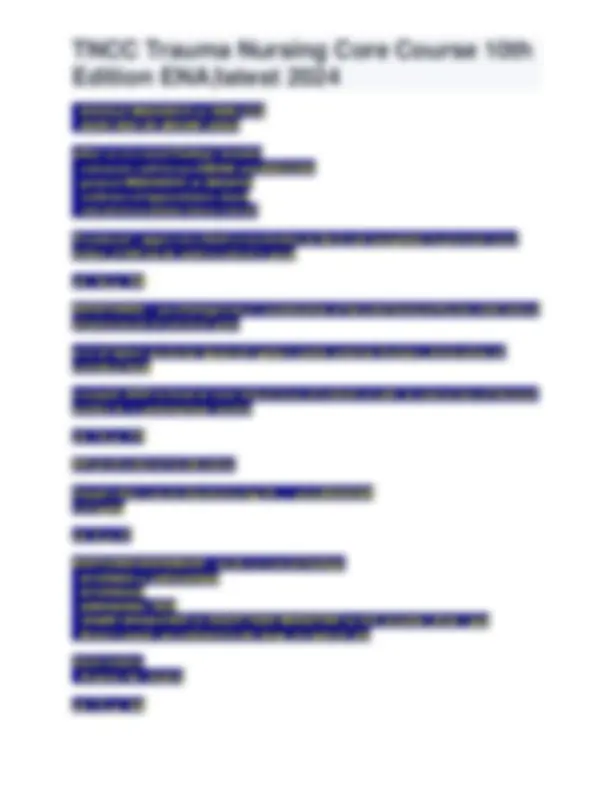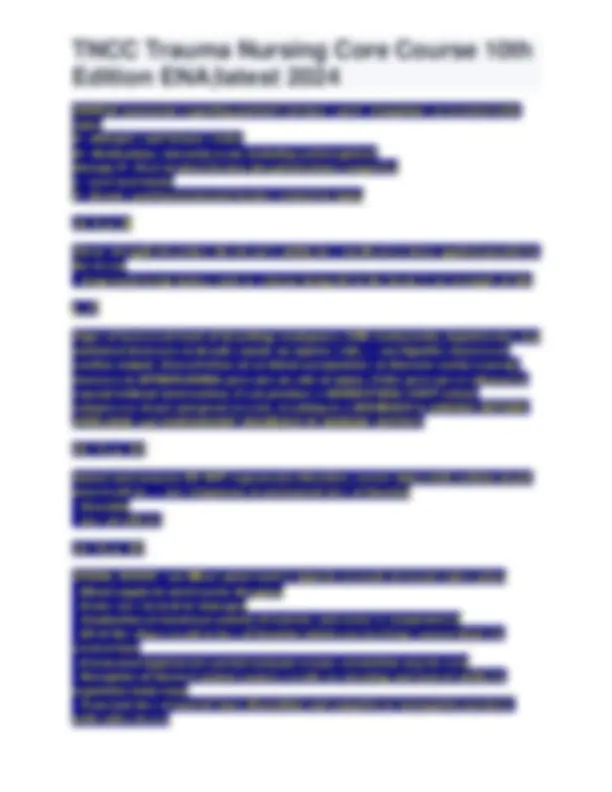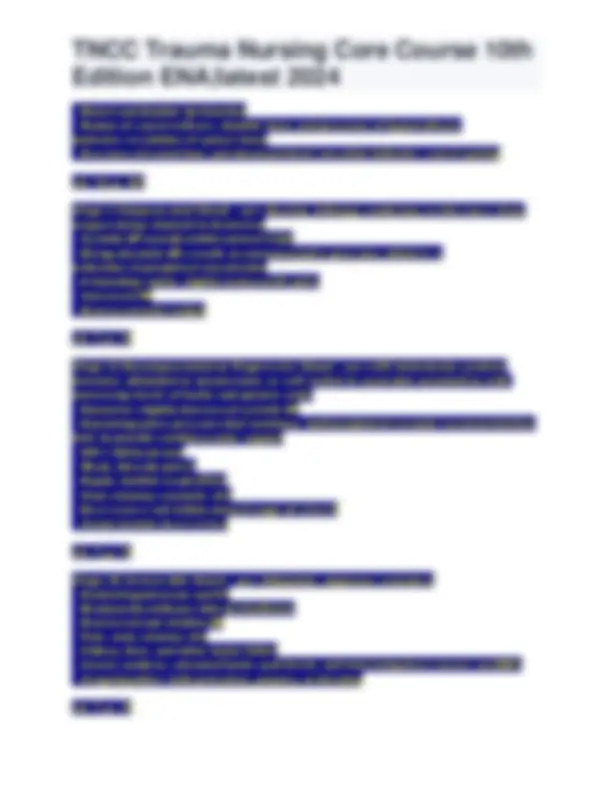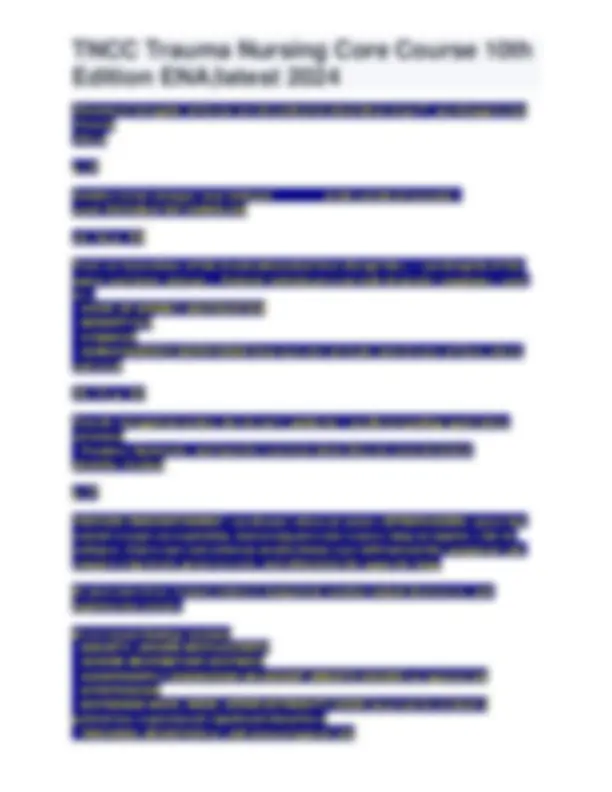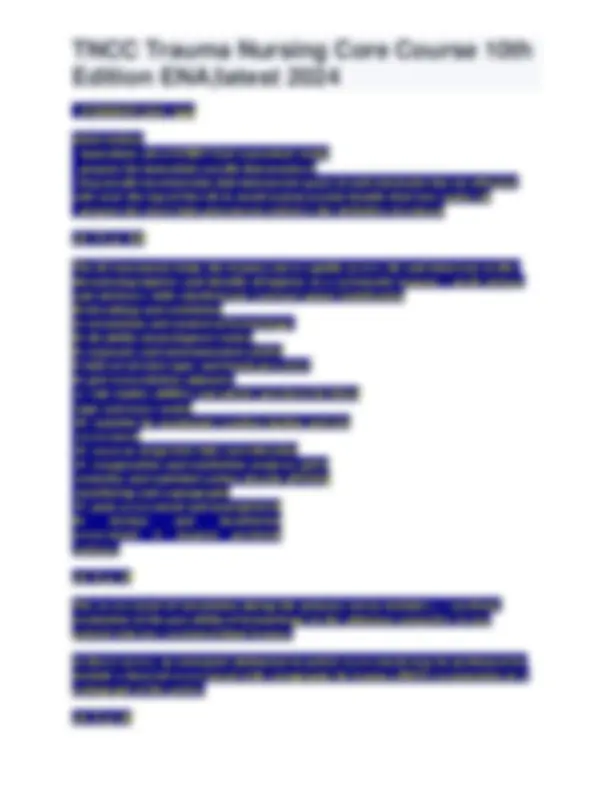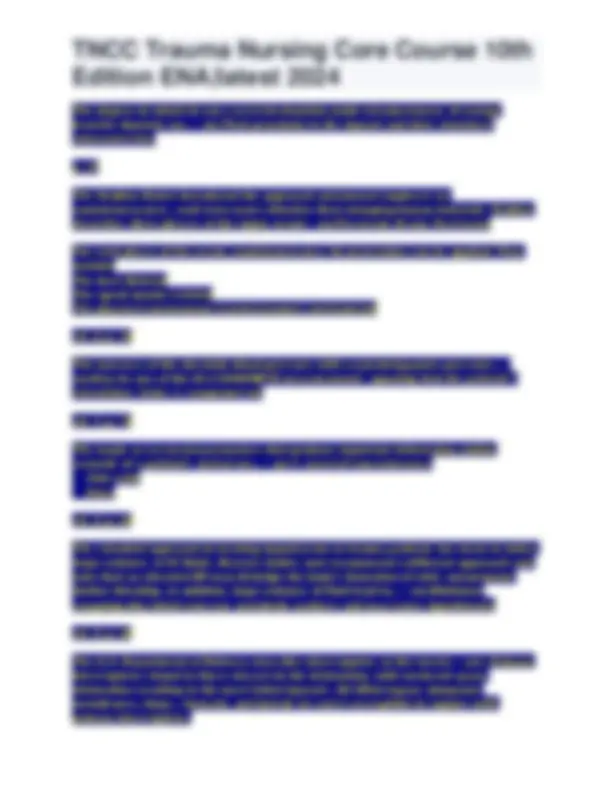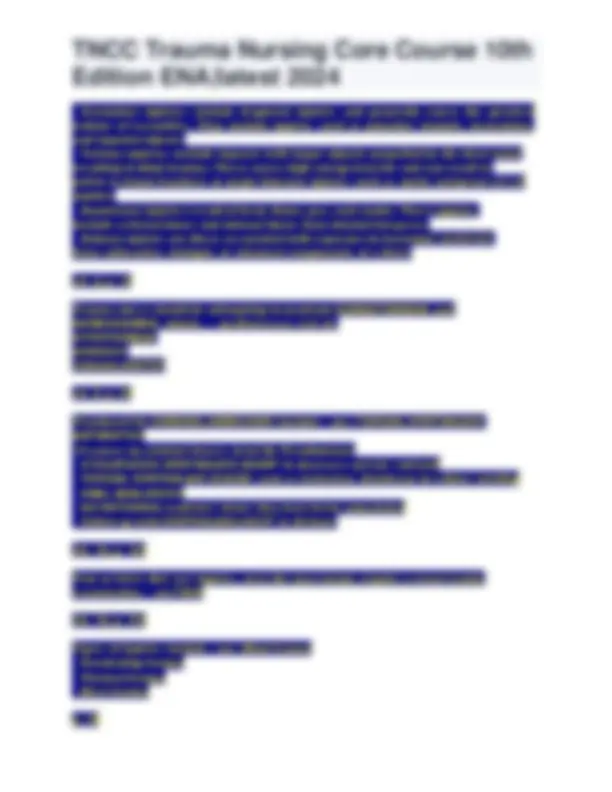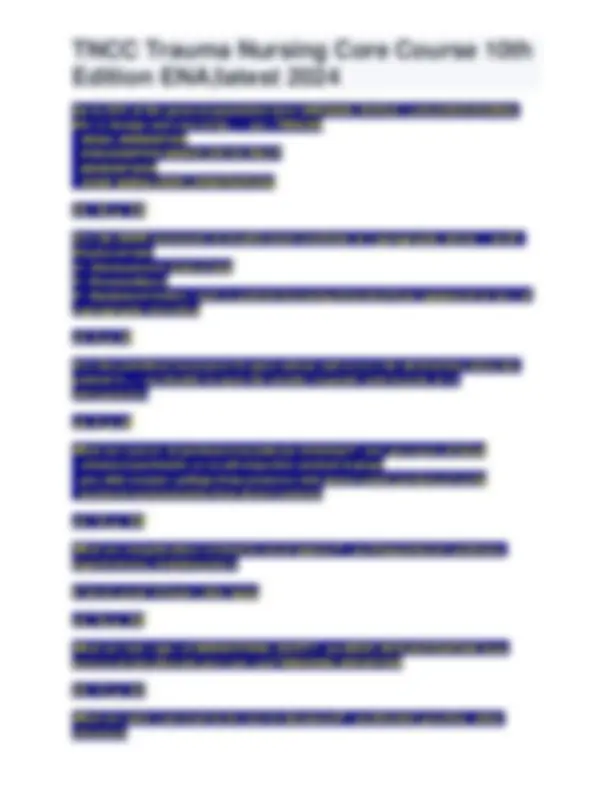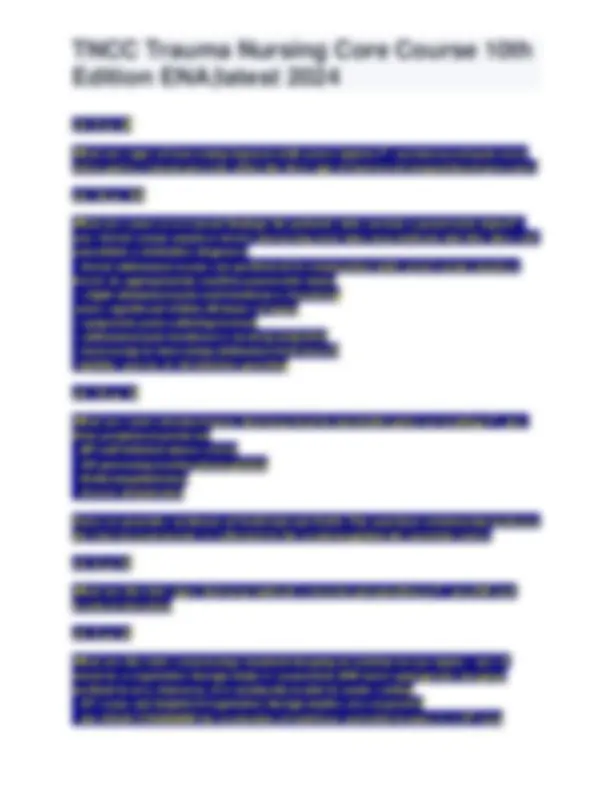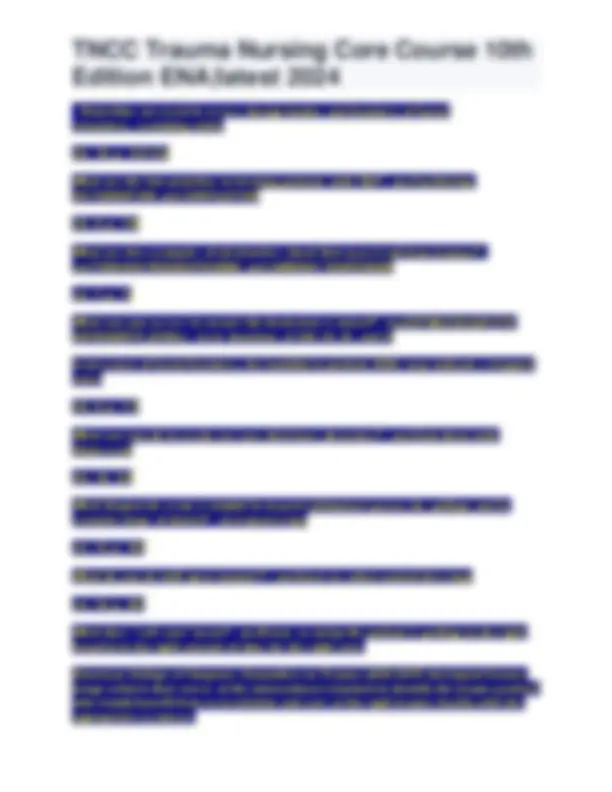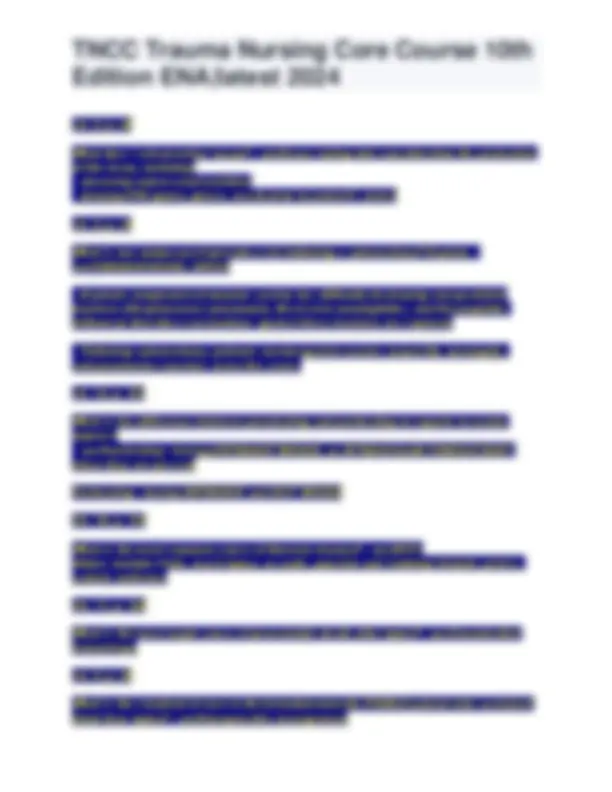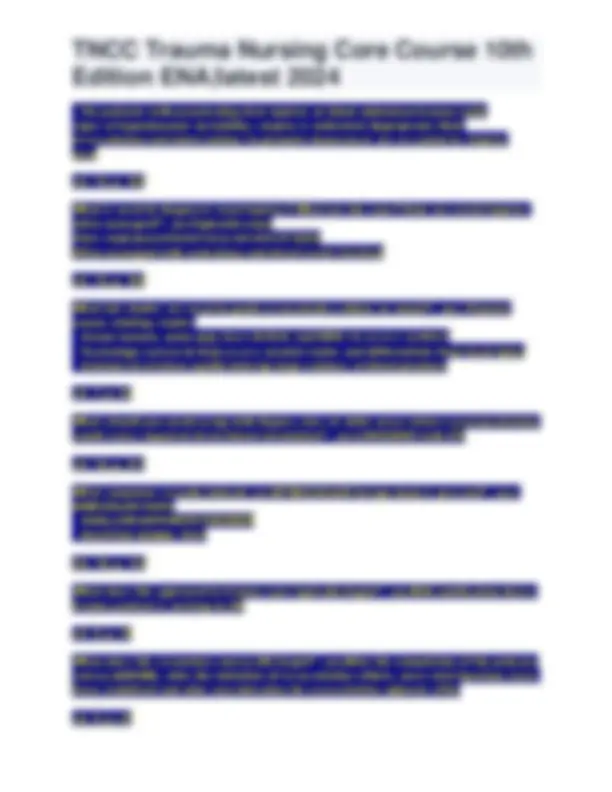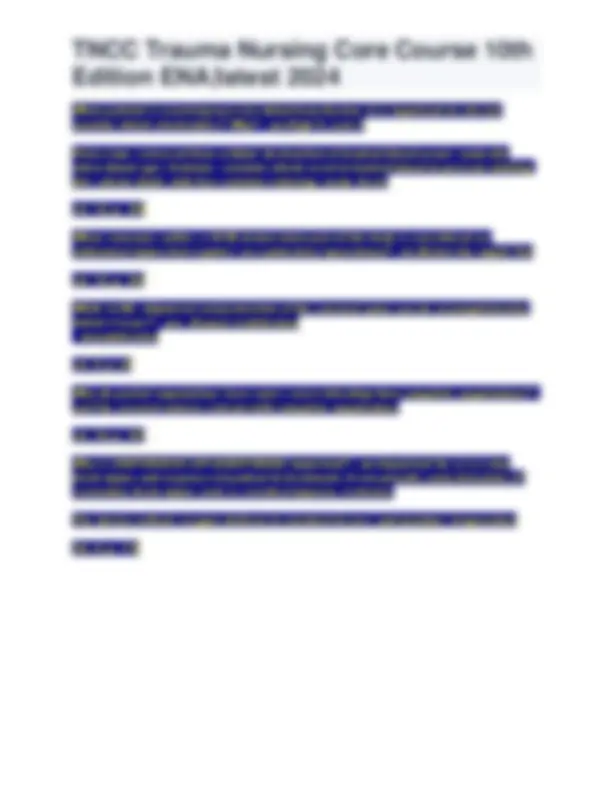Download TNCC Trauma Nursing Core Course: Practice Questions and Answers and more Exams Nursing in PDF only on Docsity!
Edition ENA|latest 2024
1. Which of the following requires you to develop a plan of action, initiate the
plan, reassess the plan as care for the patient moves forward, and adjust the plan as the patient's condition or circumstances change?
A. Principles of PHTLS
B. The Golden Period
C. The XABCDE assessment
D. Critical thinking process - ansQuestion 1: D
To help achieve the PHTLS goals, you will apply your critical thinking skills in the field. Critical thinking in medicine is a process in which the healthcare practitioner assesses the situation, the patient, and the resources available and uses the information to decide on and provide the best care for the patient.
1. You and your partner are responding to a call for a 2-year-old patient with a
burn injury to the hand. He has a visible burn to the left hand, ending at the level above the wrist, red color, and wet in appearance. What type of burn do you suspect the patient has sustained?
A. Superficial (first degree)
B. Partial thickness (second degree)
C. Full thickness (third degree)
D. Subdermal (fourth degree) - ansQuestion 1: B
Scald burns are the most common burns seen in the pediatric population ages 1 to 5 years. Scalds are partial thickness burns. The dermal layer is damaged, and blisters are present or popped. It is also the most painful type of burn.
1. You are called to the scene of a possible mass casualty motor vehicle collision on
the highway. Once you arrive on scene, what is your first priority?
A. Immediately begin triaging patients.
B. Treat the patient with the most visible blood loss.
C. Determine the need for additional resources.
D. Assess the scene and ensure it is safe. - ansQuestion 1: D
Ensure safety for responders, bystanders, and patient(s). The first consideration when approaching any scene is the safety of all emergency responders. When EMS personnel become victims, they not only can no longer assist others, but also add to the number of patients.
1. You are called to the scene of an explosion and fire at a chemical plant where
you find multiple casualties.Triage has begun. Your first patient is a 40 - year-old man who was near the source of the explosion. He is unconscious and has extensive injuries. You note gurgling respirations. Why should you use the trauma jaw thrust maneuver first when dealing with a trauma patient?
A. It's an easy technique that always works to open the airway.
Edition ENA|latest 2024
B. It allows you to open the airway with little or no movement of the head and
cervical spine.
C. Other techniques and interventions don't work as well.
D. It can relieve a variety of anatomic airway obstructions in patients who are
breathing spontaneously. - ansQuestion 1: B Manual maneuvers like the trauma jaw thrust or chin lift are always the first airway maneuver you should make when treating a trauma patient. In patients with suspected head, neck, orfacial trauma, the cervical spine is maintained in a neutral in-line position.The trauma jaw thrust maneuver allows you to open the airway with little or no movement of the head and cervical spine.
1. You are responding to a call for 25-year-old, fit and healthy female who fell off a
mountain bike. Upon arrival, you find the patient walking around. She is alert but complaining of pain in her clavicle and on her right side when she inhales. You notice that her helmet is split in two. What is the first thing you need to do? A. Complete a review of the ABCs. B. Check motor and sensory function. C. Perform manual in-line stabilization. D. Place her on a backboard. - ansQuestion 1: C Because there's a possibility of spinal injury, you should bring the patient's head into a neutral in-line position.
- You have been performing ongoing management on a 35-year-old female patient who sustained thoracic trauma when a car hit her as she crossed the street. Originally, your electronic monitoring devices all produce results consistent with your patient's clinical condition. However, en route the trauma center, the monitors start to differ from your patient's current clinical condition each time you reassess. How should you handle this situation? A. Treat the patient's condition, not the monitor results. B. Continue to reassess the patient and record the results for the trauma center. C. Treat your patient based on the test results. D. Stop testing and wait until you arrive at the trauma center for them to perform an assessment. - ansQuestion 1: A If there are inconsistent data from electronic monitoring devices, reassess to be sure the monitor matches the patient's current clinical condition. However, it is most important to treat the patient, not the monitor, so use other signs and symptoms of potential patient deterioration.
- You're called out to an assisted living facility for a 72 - year-old woman complaining of a severe headache and experiencing increased confusion. Staff reports she fell out of her wheelchair earlier in the week but didn't appear to be hurt; however, she's become increasingly disoriented over the last day or so. Vital signs show: BP 110/90; heartrate 118 and irregularly regular; ventilation rate 20 and slightly labored; SpO2 93% on room
Edition ENA|latest 2024
- During primary survey, you find the following: . LOC: alert and oriented; speaking in full sentences . GCS: 15 . Airway: good air entry to bases . Breathing: bilateral . Circulation: skin warm, flushed, dry . Pulse rate: 112 bpm, strong andregular . BP: 90/42 mm Hg . Pain: Patient complains of severe pain at clavicle site and pain on inspiration at site of possible fractured ribs. No other injuries detected. What is your next step?
A. Apply a cervical collar and in-line immobilization device.
B. Treat for hypovolemic shock.
C. Apply an arm sling for the clavicle injury.
D. Administer pain medication. - ansQuestion 2: A
Although the patient's GCS is normal, she does have a distracting injury, and the state of her helmet indicates possible spinal compression/flexion, so you should immobilize the patient.
2. The patient becomes apneic. You suspect he has a cervical injury. Which type
of airway should you use?
A. Supraglottic airway
B. Blind nasotracheal intubation
C. Oropharyngeal airway
D. Surgical airway - ansQuestion 2: A
The supraglottic airway's greatest advantage is that it can be inserted independent of the patient's position, which may be especially important in trauma patients with high suspicion of cervical injury.
2. The patient's care giver is a babysitter who reports the child was crawling on
the counter and placed his hand in a pot of water that was boiling on the stove. She is applying ice to the burn and the child is shivering. What is your next step?
A. Administer analgesia for pain.
B. Cover the patient with a blanket to stop the shivering.
C. Start IV for fluid resuscitation.
D. Stop the burning process and remove the ice pack. - ansQuestion 2: D
A common error that results in damage to the zone of stasis is the application of ice by a bystander or prehospital care practitioner. When ice is applied to a burn, the patient will experience some reduction in pain; however, the pain relief will be at the expense of additional tissue destruction.
2. The patient's respiration improves markedly, but he remains confused. He has
an absent radial pulse, and his carotid pulse is fast and thready. Your partner asks if he can let the compression go to put in an IV. How should you respond?
Edition ENA|latest 2024
A. "Oh yes, that's a great idea!"
B. "Yes, but we have to immobilize him first"
C. "Take a blood pressure first to see if he needs an IV."
D. "No, keep the pressure and let's get out of here!" - ansQuestion 2: D
This patient is likely in decompensated shock with internal bleeding, so rapid transport is the next priority. You should maintain pressure on the wound, because having massive external bleeding start up again is the last thing you want in this situation.
2. Upon examination, you find the patient responsive to your presence, although she
is clearly confused. Motor response shows reduced pain response but normal flexion. What's her GCS score?
A. 15
B. 12
C. 10
D. 8 - ansQuestion 2: B
Eye opening: 4; verbal response: 4; motor response: 4 = 12
2. When using the XABCDE assessment, which of the following takes precedence
over all other actions?
A. Controlling severe bleeding from a limb or other compressible site
B. Airway stabilization and assessing circulatory status
C. Exposing the body to allow a thorough evaluation
D. Ensuring adequate breathing - ansQuestion 2: A
The "X" placed before "ABCDE" in the primary survey refers to the need to address exsanguinating hemorrhage immediately after establishing scene safety and before addressing airway. Severe exsanguinating hemorrhage, particularly arterial bleeding, has the potential to lead to loss of total or near total blood volume in a relatively short period of time.
2. You are responding to a call to an MVC involving one patient. When you perform
your primary survey, you find a patent airway, but abnormalities with breathing and circulation. You suspect hypovolemic shock, but cannot determine the source. What does this finding most likely indicate?
A. Hemothorax
B. Intra-abdominal bleed
C. Blunt cardiac injury
D. Diaphragmatic rupture - ansQuestion 2: B
The most reliable indicator of an intraabdominal bleed is the presence of hypovolemic shock from an unexplained source.
2. You have determined that you are going to need to perform orotracheal intubation
on a 50-year-old male motor vehicle crash (MVC) critically injured trauma patient due to prolonged transport time. What do you need to do first?
Edition ENA|latest 2024
A. Preferences
B. Phases
C. Principles
D. Transport - ansQuestion 3: C
The science of medicine provides the principles of medical care. Simply stated, principles define the duties required of the prehospital care practitioner in optimizing patient survival and outcome.
3. While en route to the hospital, you manage to put an 18 - gauge IV in the right
arm. Your patient is still confused, and you still have no radial pulse. Your next move is to:
A. give 1 - L fluid bolus.
B. give one 250 - mL fluid bolus, and then stop.
C. give fluid until you get a radial pulse.
D. administer TXA. - ansQuestion 3: C
Now is the time to titrate IV fluids to restore tissue perfusion. Giving 1 liter blindly could overshoot your target pressure and reinforce internal bleeding. TXA is not a priority, although it can run parallel to fluids.
3. Why might it be more difficult to deal with an airway obstruction in a child?
A. Children have longer tracheas.
B. Children have larger heads and tongues so there is a greater potential for
airway obstruction.
C. Children have smaller heads, so there is less room to clear the obstruction.
D. A child's epiglottis is smaller and stiffer than an adult's. - ansQuestion 3: B
Children have larger heads and tongues as compared to an adult so there is a greater potential for airway obstruction in a pediatric patient. You must pay special attention to the proper positioning of a pediatric patient to maintain a patent airway.
3. You are oxygenating a pediatric patient using a properly fitted oxygen mask and
the "squeeze-release-release" timing technique. As you watch for the rise and fall of the chest, you check end-tidal CO2 (ETCO2) monitoring aiming to maintain what level?
A. Between 40 and 45 mm Hg
B. Between 30 and 35 mm Hg
C. Between 35 and 40 mm Hg
D. The level is irrelevant because capnography is inaccurate in pediatric
patients. - ansQuestion 3: C The proper level to maintain is between 35 and 40 mm Hg.
3. You are transporting a 37 - year-old male patient with a suspected
intraabdominal bleed. His blood pressure is 70/50 mm Hg (MAP 57), and his skin is pale and diaphoretic. How will you manage fluid resuscitation for this patient?
A. Aggressively administer IV fluids to compensate for internal blood loss.
Edition ENA|latest 2024
B. Do not administer IV fluids to patients with intra-abdominal bleeding.
Edition ENA|latest 2024
4. What type of padding should you provide for this patient?
A. Use compressible padding under the shoulders and torso to prevent hyperflexion.
B. Use firm padding between the back of the head and the backboard to
prevent hyperextension.
C. Do not use any padding. It can cause extension or flexion in the neck.
D. No padding needed, but to avoid decreased venous return you should tip
the backboard to a left lateral position. - ansQuestion 4: B Because the patient is an adult, you should use firm padding between the back of the head and the backboard to prevent hyperextension. You would pad a child's shoulder and torso to prevent hyperflexion, and you would tip the backboard for a pregnant patient to prevent decreased venous return.
4. When you examine the patient's pupils, you notice the right one is dilated
significantly and her motor response on the left is delayed. What does this suggest?
A. Coup-countercoup injury
B. Hyphema
C. Hypoxia
D. Uncal herniation - ansQuestion 4: D
When the medial portion of the temporal lobe (uncus) is pushed toward the tentorium and puts pressure on the brain stem, herniation compresses CN III, the motor tract, and the reticular activating system on the same side, resulting in a dilated or blown pupil on the same side, motor weakness on the opposite side, and respiratory dysfunction, progressing to coma.
4. Which of the following is a goal of the Golden Period?
A. Provide written documentation from field care to receiving hospital.
B. Expedite the field care and transport of the patient.
C. Use a team approach for optimal patient care.
D. Use the XABCDE approach to patient assessment. - ansQuestion 4: B
One of your most importantresponsibilities as a prehospital carepractitioner is to spend as little time onthe scene as possible and expedite yourfield care and transport of the patient.Studies show that the time from injuryto arrival at the appropriate site fordefinitive care is critical to survival.
4. Why might you consider early mechanical ventilation via bag-mask device
in a geriatric patient?
A. Shorter tracheas in geriatric patients create the need for ventilation assistance.
B. Laxity of the rib cage makes hyperventilation more likely.
C. Geriatric patients have greatly limited physiologic reserve.
D. Geriatric patients have a greater alveolar surface area of the lungs. - ansQuestion
4: C
Edition ENA|latest 2024
Early mechanical ventilation via bag mask device or advanced airway measures should be considered in geriatric trauma patients because of their greatly limited physiologic reserve.
5. Which of the following signs would be most concerning at this point?
A. A drop in systolic blood pressure to 88 mm Hg
B. SpO₂ of 93%
C. A field GCS motor score of 4
D. Hemiplegia on the left side - ansQuestion 5: A
A systolic blood pressure of less than 90 mm Hg indicates secondary brain injury. Her SpO2 is > 90%, and a motor score of 4 is not as concerning.
5. While attempting to lay the patient supine for spinal motion restriction she
becomes increasingly distressed and complains of shortness of breath and difficulty breathing. The fractured clavicle appears to move distally and increases the difficulty of breathing as the patient lies back. What should you do?
A. Tip the backboard to a left lateral position.
B. Raise the back of the stretcher.
C. Let her sit up in a position of comfort.
D. Administer morphine. - ansQuestion 5: B
Because laying the patient supine increases the risk of airway/ventilation problems, raising the back of the stretchers slightly fundamentally maintains spinal alignment while reducing the ventilation issues.
5. You now perform a secondary survey. You notice a sternotomy scar. Your
patient tells you he is on oral clopidogrel since he had a coronary artery bypass graft 2 years ago. Is this information useful?
A. No, he should stop talking and breathe.
B. Yes, he should see a cardiologist once in the local hospital.
C. Yes, he will need platelets and a heart surgeon ASAP.
D. Yes, you should raise his blood pressure up to 130 mm Hg systolic. - ansQuestion
5: C
Because he is on clopidogrel, his platelets are out of order for at least 5 days, so he will require urgent platelet transfusion.
6. According to the Monro-Kellie doctrine, what happens to the brain when it is still
in a compensated state after a TBI?
A. CSF, ICP, heart rate, and blood pressure are still within normal range.
B. CSF increases, ICP decreases, heart rate increases, and blood pressure decreases.
C. CSF and blood volume decrease, while heart rate and blood pressure are still
within normál range.
D. CSF decreases, ICP increases, heart rate decreases, and blood pressure
increases.
Edition ENA|latest 2024
ch. 7, p. 77 Additional history includes the following (MIST mnemonic) prehospital report: - ans- MOI
- Injuries sustained
- Signs and Symptoms (in the field)
- Treatment (in the field) ch. 5, p. 47 All open fractures are considered contaminated due to exposure to the environment and are at risk for infection. These sites of injury have poor wound healing with a risk of.... - ansOSTEOMYELITIS and SEPSIS ch. 14, p. 197 Anterior cord syndrome - ansloss of pain and temperature sensation with weakness, paresthesia, and urinary retention ch. 13, p. 182 AORTIC DISRUPTION - ansAssessment findings
- Fractures of sternum, first or second rib or scapula
- CARDIAC MURMURS
- BACK, CHEST PAIN
- UNEQUAL EXTREMITY PULSE STRENGTH or BLOOD PRESSURE (Significantly greater in upper extremities)
- HYPOTENSION
- TACHYCARDIA
- SKIN CHANGES: diaphoresis, pallor, cyanosis
- PHARAPLEGIA (due to disruption of spinal perfusion from aortic injury)
- Radiograph findings include- left hemothorax, right-sided tracheal deviation, widened mediastinum Interventions
- Prepare for surgery or angiography
- Consider massive transfusion protocol ch. 11, p. 146 Are the lumen contents of the small bowel considered sterile? What is the pH? - ansneutral pH, and sterile ch. 12, p. 164
Edition ENA|latest 2024
As ICP rises, CPP , resulting in cerebral ischemia, hypoxemia, and lethal secondary insult. - ansDECREASES Ch. 9, p. 109 As shock progresses, primary goal of the body is to maintain perfusion to vital organs. Sympathetic stimulation has little effect on the cerebral and coronary vessels since they are capable of autoregulation. Cerebral autoregulation maintains a constant... - anscerebral vascular blood flow as long as the MAP is maintained between 50-150... when autoregulation in the brain fails, perfusion becomes dependent solely on pressure. ch. 7, p. 78 Assess pupils for... - ansEquality, shape, and reactivity (PERRL) ch. 5, p. 45 Assessment findings for MILD, MODERATE, and SEVERE TRAUMATIC BRAIN INJURY INCLUDE: - ansMILD
- GCS 13 - 15
- Brief (<30 min) LOC
- POST-TRAUMATIC AMNESIA < 24 hours
- No change on neuron aging studies MODERATE
- GCS score 9 - 12
- Wide variety of symptoms, including ALTERATIONS IN CONSCIOUSNESS, CONFUSION, AMNESIA, and FOCAL NEUROLOGICAL DEFICITS
- May deteriorate to severe head injury over time SEVERE
- GCS score <
- Significant alterations in consciousness
- ABNORMAL PUPILLARY RESPONSE
- ABNORMAL POSTURING Ch. 9, p. 115 Assessment findings for renal injuries include - ans- Turner sign (bruising by 11th and 12th ribs)
- Hematuria
- Frank tenderness, costovertebral angle tenderness, palpable flank mass
- Structural damage or leakage of contrast on intravenous pyelogram (IVP)
Edition ENA|latest 2024
- ABNORMAL MOTOR POSTURING (FLEXION/EXTENSION) Extension is associated with brainstem HERNIATION and poor outcomes
- IPSILATERAL UNILATERAL FIXED, DILATED PUPIL
- RAPID DETERIORATION IN NEURO STATUS Ch. 9, p. 114 Assessment findings of a HERNIATION SYNDROME - ans- ASYMMETRIC PUPILLARY REACTIVITY
- UNILATERAL or BILATERAL PUPILLARY DILATION
- ABNORMAL MOTOR POSTURING
- other evidence of neurologic deterioration (loss of normal, reflexes, paralysis, or change in LOC) Ch. 9, p. 115 Assessment findings of a INTRACEREBRAL HEMATOMA - ans- PROGRESSIVE, RAPID DECLINE IN LOC
- HEADACHE
- SIGNS OF INCREASING ICP
- PUPIL ABNORMALITIES
- CONTRALATERAL HEMIPARESIS
- HEMIPLEGIA
- ABNORMAL POSTURING Ch. 9, p. 114 Assessment findings of an ACUTE SUBDURAL HEMATOMA - ans- SEVERE HEADACHE
- CHANGES IN LOC
- IPSILATERAL DILATED or NONREACTIVE PUPIL
- CONTRALATERAL HEMIPARESIS Ch. 9, p. 114 Assessment findings of DIFFUSE AXONAL INJURY - ans- UNCONSCIOUSNESS Mild DAI lasts 6 - 24 hrs Severe DAI lasts weeks to months
- INCREASED ICP
- ABNORMAL POSTURING
- HTN (systolic BP between 140 - 160)
- HYPERTHERMIA (104- 105 F)
- EXCESSIVE SWEATING
Edition ENA|latest 2024
- MILD TO SEVERE MEMORY LOSS; COGNITIVE, BEHAVIORAL, and INTELLECTUAL DEFICITS Ch. 9, p. 116 AXIAL LOADING - ansetiology/cause- direct force transmitted along the length of vertebral column rest of injury- deformity of vertebral column, secondary edema of spinal cord resulting in neurologic effects example- diver striking head on bottom of pool ch. 13, p. 179 Because calcium is a vital part of the clotting casade, hypocalcemia, as a result of a massive transfusion, can actually worsen hypovolemic shock by... - ansPermitting continued bleeding Signs of hypocalemia include- dysrhythmias, muscle tremors, and seizures ch. 7, p. 81 BLUNT ESOPHAGEAL INJURY - ansInjury to esophagus, rare, results form blunt trauma Assessment findings include
- AIR in MEDIASTINUM with possible widening
- CONCURRENT LEFT PNEUMOTHORAX or HEMOTHORAX
- ESOPHAGEAL MATTER IN CHEST TUBE
- SUBCUTANEOUS EMPHYSEMA Interventions
- Prepare for surgery Ch. 11, p. 143 Brown-squared syndrome - ansContralateral loss of pain and temperature sensation and ipsilateral paralysis with reduced touch sensation ch. 13, p. 182 CARDIAC TAMPONADE - ansAssessment findings
Edition ENA|latest 2024
S: This is a Safety issue/ I am Stressed Purpose- used to "stop the line" if a team member senses or discovers an essential safety breach p. 7 Components of DESC and its purpose - ansD: Describe the specific situation or behavior E: Express your concerns or how the situation makes you feel S: Suggest alternatives and seek agreement C: State consequences in terms of impact on performance goals Purpose- used in conflict management; paraphrasing the other person's comments is an important technique that should be done throughout the DESC script. Following discussion of consequences, team members should work towards consensus. p. 7 Components of SBAR and its purpose - ansS: Situation B: Background A: Assessment R: Recommendation Purpose- to provide framework for communication amount members of the healthcare team p. 7 Compression may occur from the effects of chemical substances and can cause.. - ansEdema, restricting or obstructing the airways, oxygenation, and ventilation. This can result from aspiration of liquids or inhalation of powder or noxious gas. ch. 4, p. 33 - 34 Compression strength refers to the tissue's ability to: - ansResist crush force
- Compression injuries to organs occur when the organs are crushed from surrounding internal organs or structures such as a seatbelt worn up across the abdomen causing compression of the small bowel or a fracture to the lumbar spine p. 27 Consider ABGs. A decreased level of consciousness may be an indicator of... - ansDecreased cerebral perfusion, hypoventilation, or acid-base imbalance. ch. 5, p. 46
Edition ENA|latest 2024
Define biomechanics - ansThe general study of forces and their effects p. 25 Define kinematics - ansThe study of energy transfer as it applies to identifying actual or intentional injuries p. 25 Define mechanism of injury (MOI) - ansHow external energy forces in the environment are transferred to the body p. 25 Define trauma - ans- Trauma is injury to living tissue caused by extrinsic agent
- Regardless of MOI, trauma creates stressors that exceed the tissue's or organ's ability to compensate p. 9 Depending on the motorcycle design and rider positioning, the lower extremities can collide with the handlebars, resulting in... - ansFemur and pelvis fractures and hip dislocations p. 31 Describe ANAPHYLACTIC SHOCK - ansResults from release of inflammatory mediators (e.g. histamine) which contracts bronchial smooth muscles and increases vascular permeability and vasodilation. ch. 7, p. 75 Describe DISTRIBUTIVE SHOCK - ansOccurs as result of maldistribution of an adequate circulating blood volume with loss of vascular tone or increased permeability. ch. 7, p. 75 Describe energy forms - ans- Mechanical (energy transfer from one object to another in the form of motion)
- Thermal (energy transfer of heat in environment to the host)
- Chemical (heat energy transfer from active chemical substances such as chlorine, drain cleaner, acids, or plants)
- Electrical (energy transfer from light socket, power lines, or lightning)

